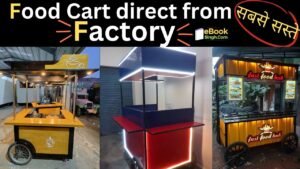Starting a food cart business can be an exciting and rewarding entrepreneurial venture, offering the opportunity to share your culinary creations with a wide audience. However, it requires careful planning and execution to ensure success. Here’s a comprehensive guide to help you start your food cart business:
1. Conduct Thorough Market Research
Identify Your Target Market: Understanding who your customers are is crucial. Are you targeting office workers, students, or tourists? Knowing your audience will help tailor your menu and marketing strategies to meet their needs and preferences.

Analyze Competitors: Investigate other food carts and food trucks in your area. What are they offering, and at what price points? Identifying gaps in the market or potential areas for differentiation can give you a competitive edge.
Assess Demand: Determine the demand for different types of cuisine and food items in your area. This can be done through surveys, focus groups, or by observing popular food trends.
2. Develop a Solid Business Plan
A well-structured business plan serves as a roadmap for your food cart business and is essential for attracting investors or securing loans.
Business Concept: Define the type of food you will offer. Whether it’s gourmet hot dogs, ethnic cuisine, or health-conscious smoothies, make sure your concept is clear and unique.
Market Analysis: Include the findings from your market research. Highlight your target market, competitive landscape, and market needs.
Marketing Strategy: Outline how you plan to attract and retain customers. This might include social media marketing, attending local events, offering promotions, and more.
Financial Projections: Create detailed financial forecasts, including startup costs, operating expenses, projected sales, and break-even analysis. This will help you understand how much funding you need and when you can expect to become profitable.
3. Handle Legal Requirements and Permits
Navigating the legal aspects of starting a food cart business can be complex, but it’s essential for operating legally and avoiding fines.
Business Registration: Choose a business name and register it with your local government. Decide on the legal structure of your business (e.g., sole proprietorship, partnership, LLC).
Permits and Licenses:
- Business License: Required to operate legally.
- Food Handler’s Permit: Ensures you understand food safety and sanitation.
- Health Department Permits: Your cart must pass health inspections to ensure it meets safety standards.
- Mobile Food Vending Permit: Specific to operating a food cart.
Insurance: Invest in liability insurance to protect your business against potential lawsuits or claims related to foodborne illnesses or accidents.
4. Acquire and Equip Your Food Cart
Choosing the right food cart and outfitting it with the necessary equipment is critical to your operation.
Choosing a Food Cart: Decide whether to buy a new or used cart, or consider leasing one. Ensure the cart meets local health and safety regulations and is suitable for your menu requirements.
Equipping Your Cart: Purchase the necessary kitchen equipment, which might include grills, fryers, refrigerators, and storage units. Don’t forget utensils, containers, and other serving supplies.
5. Develop Your Menu and Source Ingredients
Creating a menu that’s both appealing and feasible within the confines of a food cart is an art.
Menu Planning: Your menu should reflect your brand and cater to your target market. Keep it concise to ensure efficiency and consistency. Include a mix of staple items and seasonal specials to attract repeat customers.
Sourcing Ingredients: Establish reliable suppliers for fresh and high-quality ingredients. Consider sourcing locally to support the community and enhance the freshness of your offerings.
6. Branding and Marketing Your Food Cart
Building a strong brand and marketing strategy will help you stand out in a crowded market.
Branding: Create a memorable brand name, logo, and cart design that reflect your business’s personality and appeal to your target market. A catchy tagline and visually appealing menu board can attract customers.
Marketing:
- Social Media: Use platforms like Instagram, Facebook, and Twitter to share your location, menu, and promotions.
- Events: Participate in local events, festivals, and markets to increase visibility.
- Promotions: Offer discounts, loyalty programs, and special deals to attract and retain customers.
- Partnerships: Collaborate with local businesses and influencers to reach a broader audience.
7. Plan Your Operations
Effective operational planning is key to the smooth running of your food cart business.
Location: Choose high-traffic locations such as business districts, parks, and tourist attractions. Be aware of local regulations regarding where food carts can operate.
Schedule: Determine your operating hours based on peak times for your target market. Flexibility is crucial, especially when starting out, to adapt to customer demand.
Staffing: If needed, hire staff and ensure they are trained in food safety, customer service, and your specific operational procedures. Having a reliable team can significantly impact your business’s efficiency and customer satisfaction.
8. Execute a Successful Launch and Focus on Continuous Improvement
Launching your food cart business is an exciting milestone, but the work doesn’t stop there.
Soft Launch: Start with a soft launch to test your operations and gather feedback. Invite friends, family, and a small group of target customers. Use their feedback to make necessary adjustments to your menu, pricing, and processes.
Continuous Improvement: Regularly monitor sales and customer feedback to identify areas for improvement. Stay updated on food trends and continuously innovate to keep your offerings fresh and exciting. Invest in ongoing staff training to ensure high standards of food quality and customer service.
9. Manage Finances Diligently
Effective financial management is crucial for the sustainability and growth of your food cart business.
Record Keeping: Maintain detailed records of all transactions, expenses, and revenues. Use accounting software to streamline this process and ensure accuracy.
Funding: If needed, explore various funding options such as small business loans, grants, or investors. Having a well-prepared business plan will be essential when seeking funding.
Profit Management: Monitor your cash flow closely to ensure you have enough funds to cover operating expenses and invest in business growth. Identify areas where you can reduce costs without compromising quality.
best food cart manufacturer video —
Conclusion
Starting a food cart business involves a lot of hard work, planning, and dedication, but it can be a fulfilling and profitable venture. By conducting thorough market research, creating a solid business plan, complying with legal requirements, choosing the right equipment, developing a unique menu, building a strong brand, and managing your operations efficiently, you can set a strong foundation for success. Continuous improvement and diligent financial management will help sustain and grow your business in the competitive food cart industry. With passion and persistence, your food cart can become a beloved fixture in your community, delighting customers with every meal.










